The brown recluse, loxosceles reclusa, is one of the more dangerous spiders indigenous in the United States. While usually not life-threatening, a brown recluse bite might lead to severe skin damage. This page gives an overview of how to identify a brown recluse and in which states in the US it appears.
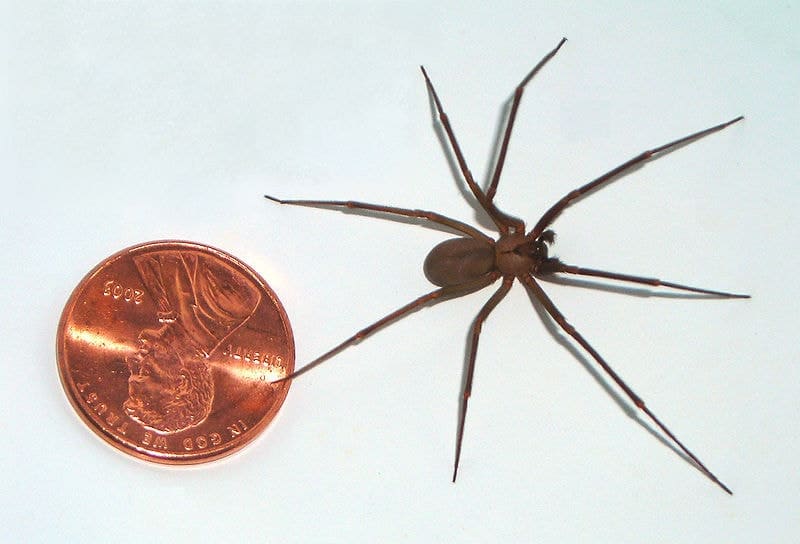
Table of Contents
Brown Recluse Description
The brown recluse spider is usually a brown to tan color, but can sometimes have more of a gray shade to it.
The Abdomen is oblong and a little larger than the cephalothorax, while the legs are approximately twice the length of the body. However, they can vary from medium to very long and lanky looking.
How to identify a brown recluse spider?
The Brown Recluse does NOT have spiny hairs on the legs, spots or stripes on the legs or abdomen, any bright colors, or short fat legs. If you see a spider with any of these, it is not the Brown Recluse. Wolf spiders or woodlouse spiders are often confused with the brown recluse, even though there are several differences between the species. Some good rules to follow in identifying the recluse spider are:
- Eyes are in three very distinctive and separate pairs for a total of 6 eyes. Two in the middle and two on each side, Each pair is tightly-knit and there is a very distinctive distance between the pairs.
- On the back of the Cephalothorax (not the Abdomen), there is a darker pattern in the shape of a violin. Hence, the reason for the nickname “the fiddle back spider”.
- Is there any other patterns or markings on the spider? If there are any markings on either part of the body or legs, other than the violin, it is not a recluse.
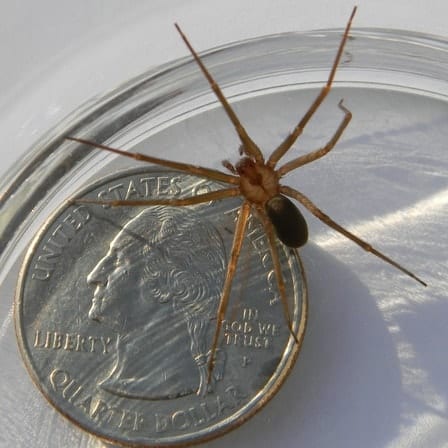
Eye Pattern
The Brown Recluse has six eyes, which are grouped into three pairs. All six eyes are about the same size. Two right next to each other in the middle, an easily discernible space to each side and another pair that is very close to each other to each side.
Size
The body will reach up to about 3/4 of an inch (19 mm) and with the legs included may be around 1 ½ inches (38 mm).
Web
Usually, the Brown recluse does not spin much of a web. It is not like many spiders that uses their web to catch prey, instead, it wanders out at night to hunt its prey. When it does spin a web, it is usually to nest and lay eggs. The web is small, sometimes as little as an inch across and looks to be randomly built with no design.
Brown Recluse Bite
The recluse is not prone to biting. It is not an aggressive spider at all. When it does bite, it is almost always due to someone pressing against one and it is forced to bite to defend itself.
In cases where it does bite, the recluse will often administer a dry bite that is virtually harmless. If it does use venom, it is often that the venom will not have much of an effect.
However, there are those bites when the venom does have a serious effect. Its venom is a cytotoxin which will break down the tissue around the bite, causing a wound that looks as if the flesh is rotting. This wound will usually grow to around 3 or 4 inches across.
Even if you might not feel a strong pain immediately, you should definitely visit a doctor if you think you’ve been bitten by a brown recluse spider. Especially if you are in one of the US states where the brown recluse usually lives.
Loxosceles reclusa Distribution in the US
The map below shows the range of the brown recluse spider in the US. The shaded areas of the map are where the spider is considered to be indigenous. The closer to the edge to a shaded area you get, the less likely it is you will find this spider. Outside the shaded area it is very unlikely you will find one.
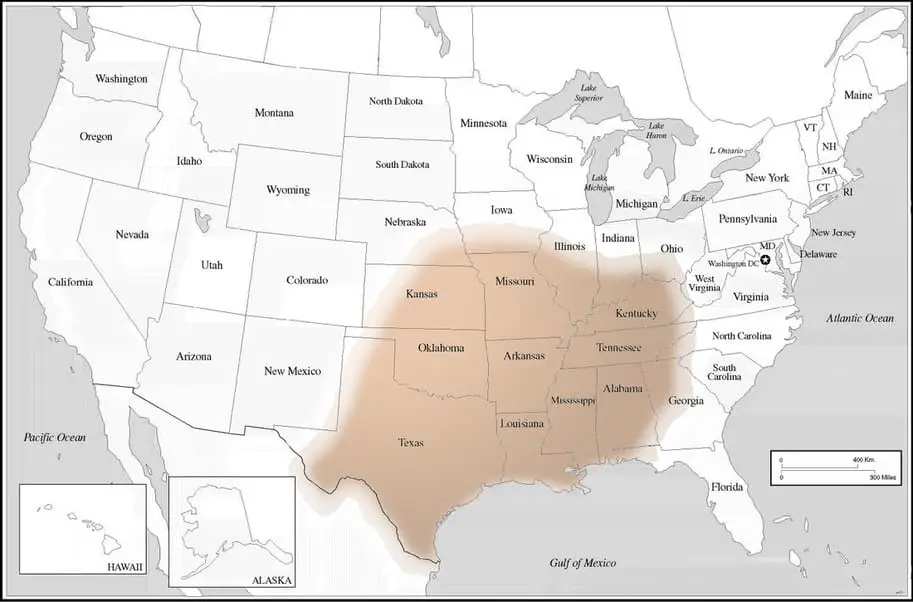
The brown recluse spider can be found in the following US states: Alabama, Arkansas, Florida, Georgia, Illinois, Indiana, Iowa, Kansas, Kentucky, Louisiana, Mississippi, Missouri, Nebraska, North Carolina, Ohio, Oklahoma, South Carolina, Tennessee and Texas.
The list here does not exclude that a brown recluse spider may also be found in any other US state. These are just the states in which the spider is mostly indigenous.
Map of other Loxosceles species in the United States
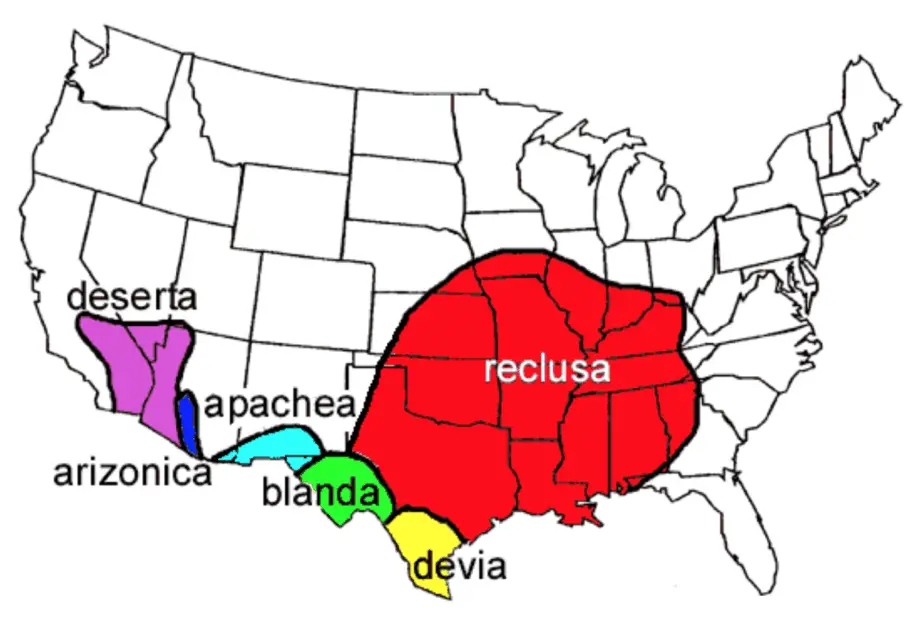
Facts about the Brown Recluse
A large number of brown recluse bites are false diagnoses
The dangers of the infamous Brown recluse have been so over blown that there are sometimes more reports of recluse bites in states where the spider is not even indigenous than in states where it is common.
The problem is that many doctors will learn about the bite in their training, especially when they train in states where the recluse is common. Then, when they have a practice in a state where the spider is not indigenous, they will often misdiagnose other serious problems as recluse bites.
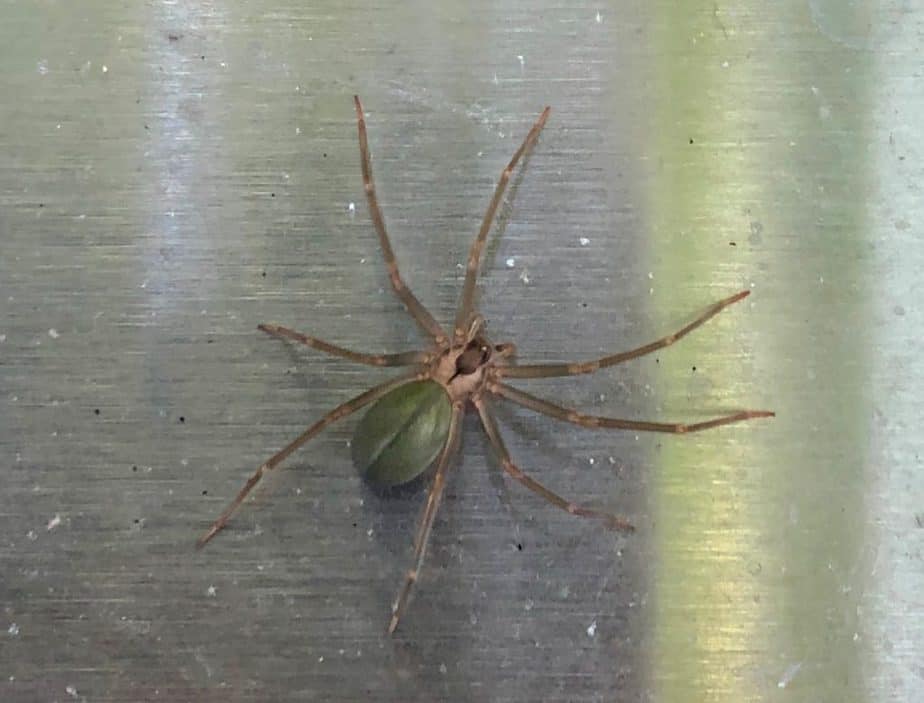
The brown recluse does not like to wander around
The recluse got its name for a reason. It is a very reclusive spider. A house can become infested with thousands of brown recluses. While the houses next door may never see even one recluse spider. They will build their colony and stick to it.
Where other spiders are known to wander, looking for a mate or good place to nest, the recluse sticks to the location it was born. They will wander at night, but never very far from their nest.
This fact and the fact that they cannot survive in freezing temperatures is the reason that the range of the Brown recluse does not expand over the years.
Though they are not indigenous to many states, there may be cases where the recluse is identified in those states. I have, for instance, been part of two cases where we identified the brown recluse spider in Michigan. And I know of a few others. These cases do not mean the Brown recluse spider is in Michigan, or any other state this happens.
It is not unheard of for boxes, crates, furniture or whatever to have recluse spiders inside them to be transferred from a state where they are indigenous to a state where they are not.
Fortunately, these spiders that are transferred will not survive in the new habitat and will not and populate those states. On a very rare occasion, there may be multiple spiders transferred, and they might breed.
As long as the building they are in stays warm, they will survive and continue to breed and colonize that building. When found, these colonies are exterminated. This is incredibly rare, though.
Its reputation is worse than the reality
The Brown recluse is one of the most feared spiders in the world. But its reputation is far worse than the truth. It is not as dangerous as most people think. That does usually not matter when it comes to fears. Because the recluse is so feared, it is reportedly biting people in every state of the country. Even in the many states where this spider is not even indigenous.
Indigenous. That is the key word here. Just because a spider is not inhabiting a specific state, does not mean it will never be found in that state. People move around a lot. People send packages all over the USA. All over the world.
Anywhere people travel or send packages, has the possibility of finding a spider that just happened to get shipped along with the item in the packaging.
These sightings do not mean that the spider is living in that state. It means a rogue spider was transferred to that state and nothing more. I will use Michigan as my example since I am from this wonderful state and am familiar with its findings. In Michigan this spider has been found and identified probably less than a dozen times now… Ever! In almost every case it was easily tracked to being brought into the state by shipment or people traveling.
You could spend the rest of your life searching for a brown recluse in Michigan and likely you will never find one. It will only be found by someone who somehow had it shipped to their home or business in some manner.
Loxosceles reclusa scientific classification
- Kingdom: Animalia
- Phylum: Arthropoda
- Subphylum: Chelicerata
- Class: Arachnida
- Order: Araneae
- Infraorder: Araneomorphae
- Family: Sicariidae
- Genus: Loxosceles
- Species: Loxosceles reclusa
Common Names
Brown recluse, fiddleback spider, brown fiddler, violin spider.

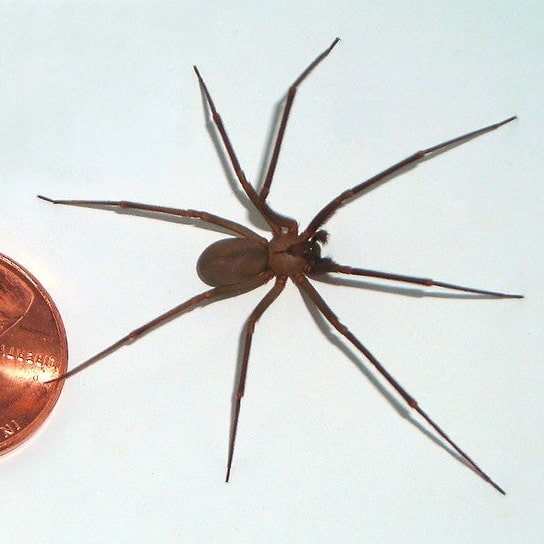
Brown recluse spider (Loxosceles reclusa) envenomation leading to acute hemolytic anemia in six adolescents National Center for Biotechnology Information, U.S. National Library of Medicine 8600 Rockville Pike, Bethesda MD, 20894 USA
How about this fella?
Hi Scott, I can’t say with certainty given the perspective and quality of the photo. But the legs and abdomen look hairy and the pedipalps are rather long – so my guess would be that this is some type of southern house spider (Kukulcania sp.)
I just found a Brown Recluse in my unheated bard in Indiana.
How would it survive freezing temps?
Brown recluse spiders are native to parts of Virginia. People keep saying they are only in the Deep South or Midwest. They extend the range to Southwest Virginia and can certainly thrive in Central Virginia. They are probably most common in the Central States. I know of several people who have been bitten by recluse spiders in Central Virginia. They were not just spiders passing through on shipments. I don’t see why people keep saying they do thrive in Virginia because they do!
Agree, Meade. They are prevalent in, and indigenous to, Central Virginia.
Oklahoma here and I think this is a recluse but it’s hard to tell deff us a fiddle on it’s back though
Hello Hunter, thanks for getting in touch! This is definitely not a brown recluse. The legs of brown recluses are long, unicolor, thin and without hairs. This is most likely some type of wolf spider. Definitely not medically significant.
found this in my moms bathroom in raymore, missouri. we think it might be a brown recluse but wanted to ask in here to verify since those are pretty dangerous. anyone able to identify this spider? it has thin legs and its brown i cant tell if thats a violin shape on its back or not however. my mom also thought it might be a thin legged wolf spider since we have had those before
Hello Sierra, thanks for getting in touch! This looks indeed like a brown recluse. There is a number of spiders that looks similar and the picture quality is a bit bad so it could be a similar looking species. But I’d treat it like a brown recluse and not handle it to be on the safe side.
Is this a wolf spider?
Hello Marianne, thanks for getting in touch! Yes, this is a wolf spider and definitely not a brown recluse.
found this spider in my bathtub, in Albertville Alabama.
Hello Delia, thanks for getting in touch! This is definitely a brown recluse spider.
What is this?
Pisaurina mira – Nursery web spider
Good Day~
I came across a spider that I’ve not seen before… Please tell me this isn’t a Brown Recluse. I’ve searched all kinds of pictures of spiders here in Washington State and know we have them but nothing I come across really looks like this one. It has a grey/brown color tone and has spinnerets. I have much respect for what spiders do and released him/her outside. Any information on what this one is would be greatly appreciated. Thank you~
Hi, sorry it took me a while to get back to you. Brown recluse spiders do not range anywhere near to Washington State. This is some type of ground spider (Gnaphosidae). They are not medically significant.
Hello Kirsty, thanks for getting in touch! There was no image attached to your post. In case of technical issues, you can also email us the image to usaspiders@gmail.com
Curious if this is a brown recluse and what I might need to do to treat my home for them, if so?
Is this a wolf spider or grass spider or something else? About 2” from end of top legs to bottom, yellowish stripe down the middle if both sections of body. In my house in Missouri. Thanks
That looks like a wolf spider to me.
Hi! Found this in my house and worried because I have a 1 year old. Can you please help me identify?
Hello Kristine, this is a yellow sac spider (Cheiracanthium sp.). They are not medically significant.
Most likely a Yellow sack spider
Not sure on what these are Have a lot at my home
Hello Mark, this is a grass spider – harmless.
Found this spider caught in my dogs water bowl this morning. Brown recluse?
Is this a brown recluse or something venomous?
Hello Cynthia, this is definitely not a brown recluse. It’s also definitely not a medically significant spider. While I can’t ID the spider off this image, I assume this is some type of orbweaver or cobweb spider.
Idk if this is aa recluse but the back leg attached part is making me worry?
Hello Heffner, thanks for getting in touch! This is a harmless cellar spider (Pholcidae): https://usaspiders.com/pholcidae-cellar-spider/
My wife is bitten by this spider. Is there a way to ID if this is brown recluse?
Hello Sam, this is definitely not a brown recluse spider and definitely not medically significant. It’s most likely a wolf spider (Lycosidae).
I’ve been bitten
Hurt so bad seem to sting then about 1-2 hours very itchy then painful to move touch hours later now it is so sore and feels hard and shiny with yellow bump has like two holes mostly red and seems to be larger row 10 hrs now my leg is hurting
Hello Nancy, I hope you are doing well. I can’t give any medical advice off a picture and description alone but I am fairly certain that this is not a brown recluse spider. Recluse bites are not painful at first and in around 1 out of 10 cases, after 2-8 hours, a local infection with a white blister develops.
Still, if you experience pain 10 hours after a spider bite, you should consult a medical professional.
Is this a Brown recluse spider
I’m in a wheelchair I started into my kitchen turned on the light is Eli seen a big spider spider it’s seen me at the same time It looked like it took one step back it’s middle body went down and up like it was going to jump at me instead instead it took off running straight for me straightforward me I backed up in my wheelchair grabbed a flies water and swatted it so it’s probably a little flat but I but I need to know if this is a Brown recluse or not
Hello Sherry, this is most likely a brown recluse spider. Due to the state of the spider and since I don’t know the location where it was found, I can’t say with absolute certainty.
This was a large spider found in a box.
Hello Julie, this is definitely a brown recluse spider (Loxosceles reclusa): https://usaspiders.com/loxosceles-reclusa-brown-recluse/
These spiders are medically significant. Can you share the location where you found it? I’d recommend always checking your shoes and clothing before putting them on to make sure there is no recluse spider in it. They are very hesitant to bite but will do so if trapped somewhere (like in a shoe).
Found this spider outside on sidewalk in Oberlin, Kansas. February 2022. Pretty big leg span…..larger than a quarter. Brown, wondering if it’s a Brown Recluce. Played dead when messing with it.
4FB6DF36-DDD7-41DE-B4F9-59E3FCE75F53
Hello Steph, thanks for getting in touch! Yes, this is most certainly a medically significant brown recluse. You should be careful when messing with it 🙂 However, despite their bad reputation, brown recluses are very hesitant to bite. Most bites occur when the spider is trapped towards human skin (e.g. in shoes or clothing).
What is this spider. It bit my boyfriends foot and now it stings and itches
Curious what kind of spider this is?
Came running towards me after turning on the lights.
67171909099__9940BF27-7230-448D-8AD2-F2A321BBEA57
In my pantry, New Orleans, Louisiana. About 6 feet up, light scattered web possibly from previous occupants (we get a lot of cellar spiders in there). No visible spinnerets, stripe most noticeable with flash, black leg bands very clear. Above my head, so I can’t get an eye picture. Beige-grey color.
Hi Christine, this is a medically significant brown recluse (Loxosceles reclusa). It’s best to handle this one with care. Also make sure to check shoes and pieces of clothing before putting them on. Also, spraying peppermint oil around entrances can help keeping spiders out.
Here is more information about brown recluses: https://usaspiders.com/loxosceles-reclusa-brown-recluse/
Found in Tennessee, in a sink
Hi Madison, this is a medically significant brown recluse (Loxosceles reclusa). It’s best to handle this one with care. Also make sure to check shoes and pieces of clothing before putting them on. Also, spraying peppermint oil around entrances can help keeping spiders out.
Here is more information about brown recluses: https://usaspiders.com/loxosceles-reclusa-brown-recluse/
Found in bathroom in Brighton, TN.
Hi James, this is a medically significant male brown recluse (Loxosceles reclusa). It’s best to handle this one with care. Also make sure to check shoes and pieces of clothing before putting them on. Also, spraying peppermint oil around entrances can help keeping spiders out.
Here is more information about brown recluses: https://usaspiders.com/loxosceles-reclusa-brown-recluse/
Found this in our sink. Got a bit wet in the picture. This is in Northern California (SF Bay Area). Any idea what this is?
Found on my living room floor in TN. I’ve never seen one like this.
Hello Glenna, I can’t be 100 % due to the lighting of the photo – but I am fairly certain that this is a medically significant brown recluse spider: https://usaspiders.com/loxosceles-reclusa-brown-recluse/
can you please help me identify this spider. i saw it today in rock island state park TN. thank you!!
Hi Will, this is a wolf spider (Lycosidae).
Hello:
I discovered a bright red bite on my collarbone early this morning and shortly afterwards saw a spider about 40 ft away on our hallway wall. Can you please help us determine if this is a brown recluse? Unfortunately, the photo isn’t the best quality and my husband didn’t think it was a recluse, so he flushed it down the toilet before we went to the ER.
I thought it’s possibly a recluse, but not quite an adult yet? It was smaller than a dime and the legs weren’t stretched out. I don’t see a “violin” in the photo, but the quality isn’t great. The ER doc said they’re rare in CT. I have searched online all day and can’t find another spider besides BR that looks like this. I have no idea how many eyes it had because we didn’t get that close. Please advise. Thank you so much.
Hello Danielle, this is definitely not a brown recluse. This is some type of sac spider, possibly Clubiona sp. The bite is much more likely from an insect than from a spider – spiders only bite in very desperate situations and this is when humans are usually aware (e.g. when putting on clothes, shoes or grabbing into a dark corner of a cupboard). Spider bites are usually always immediately notices, while insect bites appear later.
Curious what type spider this is? Anchorage, AK outdoors.
This is a wolf spider (possibly genus Trochosa).
I just felt something crawling across my belly under my shirt and hit it. This is what it was. I’m concerned it’s a brown recluse. I live in Alabama. I was just lying on my sofa.
Hi Brooke, unfortunately, the spider is quite blurry on the image so I can’t say for certain. At first glance, it looks more like some type of sac spider than a recluse – but I can’t exclude it from this picture.
For perspective from my last post of the bathroom spider/suspected brown recluse in GA…s/he’s about the same size as the example image (compared to a dime). The plastic cup is massive…
As an aside, those posting images of spiders they killed for no reason need to be educated. For example, killing a spider “in my barn!” (Is it a territorial thing? Are they supposed to pay rent?) or on an deck outdoors is not only futile, but likely counterproductive and mean to kill those which pose no threat. Totally understandable to kill a spider crawling under your shirt (that’s how I got a nasty brown recluse bite) but most of these dead spiders should have been released to the outdoors. They won’t come back begging for food like when you feed birds or whatever.
Hi – Found this guy in my kitchen in S. California.
Hi Brian, this is definitely not a brown recluse – possibly some type of male sac spider
Found this running across my floor at 330 in the morning getting up for work…cat found it
Please tell me what this is? It was in my barn!
Thank you for sharing your knowledge! Is this a brown recluse? Found under a piece of furniture in a rarely used room. Some dusty, webbing with no pattern found on the backside of the furniture.
Found this guy hanging out by my pets dish. Seen few like this and wondered if I should be worried it not.
Brown Recluse?
Found on the second floor of a house in Albuquerque, New Mexico
Found on the second floor of a house in Albuquerque, New Mexico.
Is it a Brown Recluse?
Found this making a large web off my deck where I walk…Minneapolis, Minnesota area.
Why would you kill a spider that lives outside and poses no threat to you?
Found on a second floor wall in a house in Albuquerque, New Mexico.
What about this guy. I found him on my wall. Google lens suggested in was a brown recluse. What can be done to get rid of them if it is.
Found this on the wall in my laundry room. Brown recluse?
This is a dark brown-black spider. It is about 2-3 inches long (leg tip to leg tip) in a resting position and is very large. The spider also has 2 large noticeable fangs. I’ve seen them have 6-8 legs and seem to usually come around most often in the winter. Would love to know what kind of spider this is.
Was located in Washington state
Hello Jay, this is some type of funnel-weaving spider (family Agelenidae), possibly a giant house spider: https://usaspiders.com/eratigena-atrica-giant-house-spider/
Hello Jacqi, yes, this is a brown recluse missing a right leg. Its body is deformed, it might be dehydrated. It’s best to handle it with care and check shoes and other items of clothing before putting them on to avoid getting bitten.
Here is more information about them: https://usaspiders.com/loxosceles-reclusa-brown-recluse/
Found in bathroom in Texas
I came here today bc I’m in GA and found a suspected brown recluse in my bathtub early this am. Do all brown recluses have a well defined “fiddle” on the cephalothorax? It has been quite cold outside especially at night. No visible web anywhere (I think s/he was living in the drain). S/he was probably ready to crawl back home when I found him/her. Said spider was relocated outdoors. But the fiddle on the cephalothorax isn’t clear.
Can I offer a bit of advice on safely capturing and relocating spiders and other insects? I use a large, clear plastic cup (like the type you get with a convenience store fountain drink). Because it surrounds them from all directions simultaneously and is lowered from overhead, it is very hard for them to escape. I’ve caught everything with this method, including a wayward lizard. Avoid creating vibrations. Move slowly until it’s time to lower the boom, then slip a piece of paper or whatever under the cup, quickly invert and you can safely relocate without ever touching them.
Found it crawling across my pillow beside my face in bed. Screamed like a girl found the first thing i could to smash it with. It jumped away slightly a couple times before i finally got it. I’m in the western north carolina area near Asheville. Hoping this isn’t a brown recluse. Sorry the picture isn’t the greatest but I’m definitely an arachnophobe.
Found this in my garage. I think it’s a grass spider. Fairly aggressive but hey, who wouldn’t be as a lady stands screaming over you…
Just had a visitor in my bathtub – Google Lens says brown recluse, not totally sure though. Any help would be appreciated!! I’m in the SF Bay Area, in the east bay.
Found this in the corner of my closet in Enterprise, AL. Is this a brown recluse?
Hi I’m in Iowa and I was cleaning my son’s room and I happen to see this spider in his laundry when I was getting ready to wash !
its pretty small, is this a young brown recluse? I live near Tulsa Oklahoma
Thoughts on this spider?
Thoughts on this spider?
Can you Id this?
Found this spider in my bathroom, it was pretty quick when bothered. No hair on it
This is the second one I found at the cottage in Athelstane, Wisconsin.
Little bigger than a quarter.
It didn’t seem to move
found this in a yoga mat and confused on rather its a brown recluse or a kukulcania. this was also found in oklahoma idk if that helps thank you!
Can u please identify this spider i live in iowa and I am horrified i don’t like to kill anything but it was so big I was afraid to.step.on it and I sprayed bug spray no I feel bad please me identify thank you don’t know if I said this my page will not scroll up lol I live in iowa
Union County Florida. Nest of spiders. They were making a vibrating/humming sound. They have red heads and red legs. One has a gray round body.